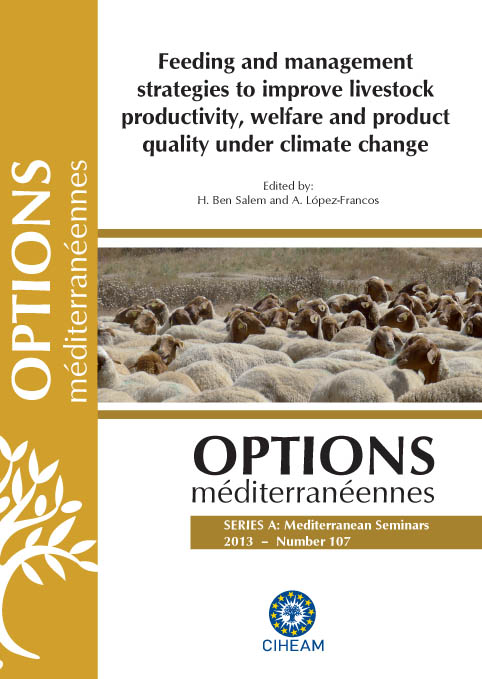| Article précédent | p. 195-200 | Article suivant |
Effect of carob pulp on growing performances, nutritional, and technological quality of meat and perirenal fat from goat
The objective of this study is to evaluate the effect of condensed tannins (CTs) distribution using carob pulp in diet on meat and carcass quality and growth performance of kids. Three diets with 0%, 25%, and 45% of carob pulp (C0, C5 and C10, respectively) were distributed to 3 groups of kids from weaning to slaughter at 6 months of age. C5 kids showed highest ADG90-180 and final weight at 180 days (73.33 g/day; 18.50 kg respectively). Meat moisture, fat, pH and water retention showed no variation. However, C5 contains more protein (P<0.05).The linoleic acid composition in meat increase with C10 (P<0.05). The low intakes of CTs seem to be insufficient to fully protect certain unsaturated fatty acids against biohydrogenation of fatty acids (DFA 67.03% vs 64.91% and 66.54% respectively for C0, C5 and C10, P>0.05). The same result was observed for perirenal fat. Omega 6 and C18:1n9 experienced an increase in meat from goats fed with the C10 diet (P>0.05). Carob use in kids diet is accompanied by an improvement of protein and desirable fatty acids, especially linoleic acid, in meat.
L’objectif de ce travail est d’évaluer l’effet de la distribution des tanins condensés (TCs) en utilisant la pulpe de caroube dans l’alimentation, sur la qualité (carcasse; viande) et sur la croissance des chevreaux. Trois rations avec 0%, 25%, 45% de pulpe de caroube (C0, C5 et C10 respectivement) ont été distribué à 3 groupes de chevreaux du sevrage jusqu’à l’abattage à 6 mois. Les chevreaux C5 ont enregistré un GMQ90-180 et un poids final à 180 jours les plus élevés (73,33 g/jour; 18,50 kg). L'humidité de la viande, la matière grasse, le pH 0 et 24h post mortem et la rétention d'eau n'ont révélé aucune variation. Toutefois, la viande C5 contient plus de protéines (P<0,05). La composition de la viande en acide linoléique a augmenté avec C10 (P<0,05). Les faibles apports de tanins semblent insuffisants pour protéger complètement certains acides gras insaturés contre la biohydrogénation des acides gras (DFA 67,03% vs 64,91% et 66,54% respectivement pour C0, C5 et C10, P>0,05). Le même résultat a été observé pour la graisse périrénale. Oméga 6 et C18:1n9 ont connu une augmentation dans la viande de chevreaux recevant la ration C10 (P>0,05). L'utilisation de la pulpe de caroube est accompagnée d'une amélioration des protéines et des acides gras désirables, en particulier linoléique, de la viande.
- [ Afficher ]
- [ Télécharger ]
- [ Exporter la citation ]
Vous pouvez télécharger la citation au format :
- [ Imprimer ]
-
Mots-clés
CAROUBE, CHEVREAU, CROISSANCE, QUALITE DE LA VIANDECiter cet article
Ayadi M., Arakrak A., Chriyaa A., Chentouf M., Bouassab A. Effect of carob pulp on growing performances, nutritional, and technological quality of meat and perirenal fat from goat. In : Ben Salem H. (ed.), López-Francos A. (ed.). Feeding and management strategies to improve livestock productivity, welfare and product quality under climate change. Zaragoza : CIHEAM / INRAT / OEP / IRESA / FAO, 2013. p. 195-200. (Options Méditerranéennes : Série A. Séminaires Méditerranéens; n. 107). 14. International Seminar of the Sub-Network on Nutrition of the FAO-CIHEAM Inter-Regional Cooperative Research and Development Network on Sheep and Goats, 2012/06/15-17, Hammamet (Tunisia). http://om.ciheam.org/om/pdf/a107/00007032.pdf



